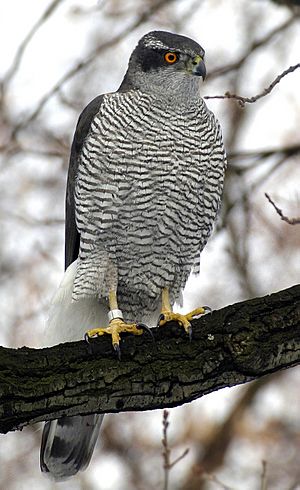Goshawk facts for kids
Goshawks are powerful birds of prey, known for their sharp eyesight and incredible hunting skills. The word "goshawk" is a common name used for many different species of birds that belong to the Accipitridae family. These amazing birds live in forests all over the world, from Europe to North America and beyond. They are often called "true hawks" because of their strong build and hunting style.
Contents
Discovering Goshawks: Amazing Birds of Prey
What Makes a Goshawk Special?
Goshawks are medium to large-sized hawks. They have broad, rounded wings and a long tail. These features help them fly quickly through dense forests. Their strong legs and sharp talons are perfect for catching prey. Goshawks are known for being very agile hunters. They often surprise their prey with a sudden burst of speed. Their diet mainly includes other birds and small mammals. They are important predators in their ecosystems.
Goshawks Around the World
There are many different types of goshawks. Each species has adapted to its specific environment. While they share many similarities, they can look a bit different depending on where they live. Let's explore some of the most well-known goshawks and where you can find them.
Goshawks in Europe and Asia: The Eurasian Goshawk
The Eurasian goshawk (scientific name: Astur gentilis) is a very famous goshawk. It is found across a huge area, from Europe all the way through Asia. In many parts of its range, it's simply called "the goshawk." These birds are skilled hunters of forest animals. They are known for their fierce and determined hunting style.
Goshawks in North America: The American Goshawk
Across the Atlantic, in North America, lives the American goshawk (scientific name: Astur atricapillus). Just like its Eurasian cousin, it's often simply called "the goshawk" in its home region. These birds prefer large, mature forests. They are powerful predators, helping to keep animal populations balanced in their habitats.
Other Goshawk Species Across Continents
Goshawks are truly global travelers! You can find different species in many other parts of the world, each with its own unique features.
- In Africa:
- The African goshawk (Aerospiza tachiro) lives in the forests of many African countries.
- The Pale chanting goshawk (Melierax canorus) is known for its beautiful, song-like calls.
- The Gabar goshawk (Micronisus gabar) is a smaller goshawk, but still a very skilled hunter.
- In Australia and nearby islands (Australasia):
- The Brown goshawk (Tachyspiza fasciatus) is a common sight in Australia.
- The Grey goshawk (Tachyspiza novaehollandiae) is special because it can have either grey or pure white feathers!
- The Red goshawk (Erythrotriorchis radiatus) is a larger, striking species with reddish-brown feathers.
- In Southeast Asia (Indomalayan region):
- The Crested goshawk (Lophospiza trivirgatus) has a small, distinctive crest of feathers on its head.
- In the Pacific Islands (Oceanian region):
- The Fiji goshawk (Tachyspiza rufitorques) makes its home on the beautiful islands of Fiji.
These examples show how diverse goshawks are. Each species plays an important role in its local environment, helping to keep nature in balance.


